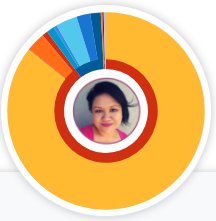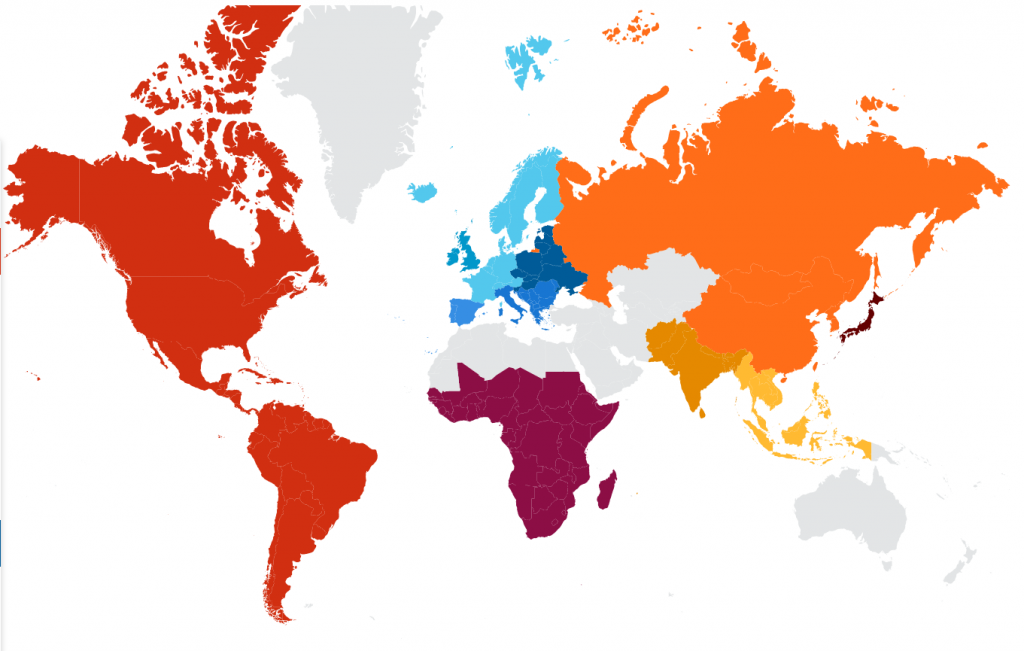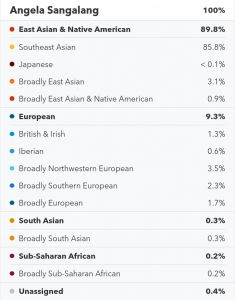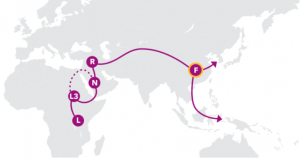 This is me. My name is Anna Angela and I’m Filipino. Okay, I’m not full Filipino. I’m also Caucasian (European and German, or so I was told). But it turns out, that’s not all of me either.
This is me. My name is Anna Angela and I’m Filipino. Okay, I’m not full Filipino. I’m also Caucasian (European and German, or so I was told). But it turns out, that’s not all of me either.
My brother gave me a 23andMe DNA Ancestry Kit for Christmas. I spit in a tube, mailed it in, filled out some forms online, waited, and waited.
The results are in and look how colorful my profile graph is. It’s mostly that yellow-orange color that represents Southeast Asian ancestry…that would be the Filipino me. There’s also a lot of blues, that would be the European me. But there’s some other colors and I was so excited to find out what my genes tell me about where I come from.
Here’s a video where I share the results!
(If you’re reading this in an email and can’t see a video, click through to the blog.)
Look a map!

This map is a colorful representation of where my ancestors are from. Some of them lived in these regions thousands and thousands of years ago, while others, only a few generations ago.
Do you like numbers? Here’s my DNA Ancestry Composition!

These percentages is what I share on the video. It’s a percentage breakdown of my DNA ancestry composition. I’m mostly Southeast Asian (In another graphic, it says Philippines underneath Southeast Asian) and mostly European. I’m a whole lot of “Broadly.” 23andMe says “Broadly” means,
Broad regional assignments: Sometimes a piece of DNA matches a regional population but cannot be assigned to a more specific population. In such a case we assign the DNA “broadly” to that regional population rather than a specific one.
And look, an Ancestry Timeline!

These dates estimate when my ancestor from a region lived. I have Southeast Asian ancestors that lived from 1930-1960. Those would be my grandparents and parents. I have British & Irish ancestors that lived between 1750-1840. Those would be the ones I traced on my family tree. Many left Europe to settle in the United States.
Now, a Haplogroup Map!

My Maternal Haplogroup is F3b1. Don’t know what a haplogroup is? Me, too. Here’s what 23andMe says about it:
A small number of DNA changes, called mutations, generally occur from one generation to the next. Because [mitochondrial] mtDNA does not recombine between generations, these mutations accumulate in patterns that uniquely mark individual lineages.
The term “haplogroup” refers to a family of lineages that share a common ancestor and, therefore, a particular set of mutations.
Looking at the map, the haplogroups start with L or one woman whose lineage survived through thousands of years of migrations to L3, N, R, and F, where I’m from.
One more great news! I “have 1 Neanderthal variant associated with having less back hair.” LESS. BACK. HAIR. Great news for sure!
I don’t want to leave you at back hair so here are my thoughts.
I’m an Enneagram 4, a unique snowflake and proud of it. I love seeing the different DNA combinations that make me, me. There is only one me (and one you), uniquely created by an imaginative God out of love and for a purpose. I also love seeing how I’m connected to different people groups, lineages, and ancestors. That’s why I love tracing my family tree. It reminds me that I belong. I am part of a family. I am part of a bigger picture.
We all are. We are part of a family, a lineage, a bigger picture. We all belong. It may not always feel that way, and people do abandon people they’re supposed to love. Yet there’s hope. We cannot sever our connection to our ancestors. It’s in our DNA, always and forever there. There is literally nothing we can do to remove that connection. Likewise is the love of God. We cannot sever it. It’s in His DNA. Always and forever, God loves us. There is literally nothing we can do to stop Him. We will always belong.
“Yes, I am sure that nothing can separate us from the love God has for us. Not death, not life, not angels, not ruling spirits, nothing now, nothing in the future, no powers, nothing above us, nothing below us, or anything else in the whole world will ever be able to separate us from the love of God that is in Christ Jesus our Lord” Romans 8:38-39, ICB.



2 thoughts on “My 23andMe DNA Ancestry Composition”